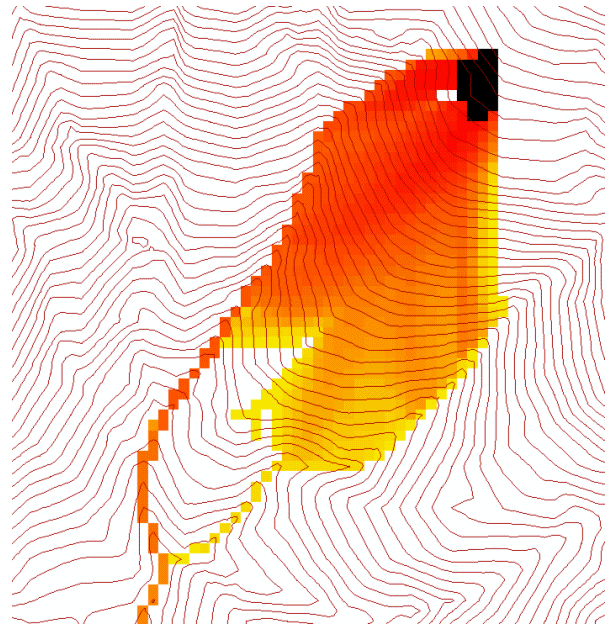D-Infinity Concentration Limited Accumulation¶
Description¶
This function applies to the situation where an unlimited supply of a substance is loaded into flow at a concentration or solubility threshold Csol over a region indicated by an indicator grid (dg). It a grid of the concentration of a substance at each location in the domain, where the supply of substance from a supply area is loaded into the flow at a concentration or solubility threshold. The flow is first calculated as a D-infinity weighted contributing area of an input Effective Runoff Weight Grid (notionally excess precipitation). The concentation of substance over the supply area (indicator grid) is at the concentration threshold. As the substance moves downslope with the D-infinity flow field, it is subject to first order decay in moving from cell to cell as well as dilution due to changes in flow. The decay multiplier grid gives the fractional (first order) reduction in quantity in moving from grid cell x to the next downslope cell. If the outlets shapefile is used, the tool only evaluates the part of the domain that contributes flow to the locations given by the shapefile. This is useful for a tracking a contaminant or compound from an area with unlimited supply of that compound that is loaded into a flow at a concentration or solubility threshold over a zone and flow from the zone may be subject to decay or attenuation.
The indicator grid (dg) is used to delineate the area of the substance supply using the (0, 1) indicator function i(x). A[] denotes the weighted accumulation operator evaluated using the D-Infinity Contributing Area function. The Effective Runoff Weight Grid gives the supply to the flow (e.g. the excess rainfall if this is overland flow) denoted as w(x). The specific discharge is then given by:
Q(x)=A[w(x)]
This weighted accumulation Q(x) is output as the Overland Flow Specific Discharge Grid. Over the substance supply area concentration is at the threshold (the threshold is a saturation or solubility limit). If i(x) = 1, then
C(x) = Csol, and L(x) = Csol Q(x),
where L(x) denotes the load being carried by the flow. At remaining locations, the load is determined by load accumulation and the concentration by dilution:

Here d(x) = d(i, j) is a decay multiplier giving the fractional (first order) reduction in mass in moving from grid cell x to the next downslope cell. If travel (or residence) times t(x) associated with flow between cells are available d(x) may be evaluated as exp(-k t(x)) where k is a first order decay parameter. The Concentration grid output is C(x). If the outlets shapefile is used, the tool only evaluates the part of the domain that contributes flow to the locations given by the shapefile.

Useful for a tracking a contaminant released or partitioned to flow at a fixed threshold concentration.
Parameters¶
- D-Infinity Flow Direction Grid [raster]
- A grid giving flow direction by the D-infinity method. Flow direction is measured in radians, counter clockwise from east. This grid can be created by the function “D-Infinity Flow Directions”.
- Disturbance Indicator Grid [raster]
- A grid that indicates the source zone of the area of substance supply and must be 1 inside the zone and 0 or NODATA over the rest of the domain.
- Decay Multiplier Grid [raster]
- A grid giving the factor by which flow leaving each grid cell is multiplied before accumulation on downslope grid cells. This may be used to simulate the movement of an attenuating or decaying substance. If travel (or residence) times t(x) associated with flow between cells are available d(x) may be evaluated as exp(-k t(x)) where k is a first order decay parameter.
- Effective Runoff Weight Grid [raster]
- A grid giving the input quantity (notionally effective runoff or excess precipitation) to be used in the D-infinity weighted contributing area evaluation of Overland Flow Specific Discharge.
- Outlets shapefile [vector: point]
Optional.
This optional input is a point shapefile defining outlets of interest. If this file is used, the tool will only evaluate the area upslope of these outlets.
- Concentration Threshold [number]
The concentration or solubility threshold. Over the substance supply area, concentration is at this threshold.
Default: 1.0
- Check for edge contamination [boolean]
This option determines whether the tool should check for edge contamination. Edge contamination is defined as the possibility that a value may be underestimated due to grid cells outside of the domain not being considered when determining contributing area.
Default: True
Outputs¶
- Concentration Grid [raster]
- A grid giving the resulting concentration of the compound of interest in the flow.
Console usage¶
processing.runalg('taudem:dinfinityconcentrationlimitedaccumulation', -ang, -dg, -dm, -q, -o, -csol, -nc, -ctpt)